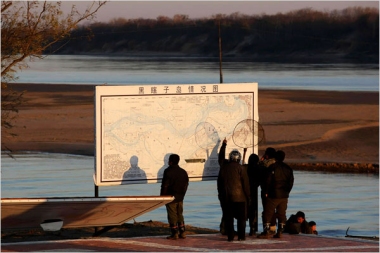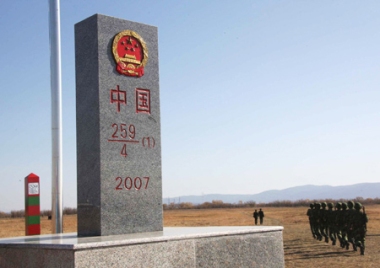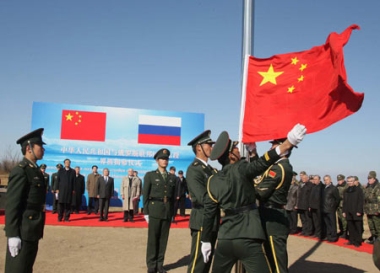China, Russia hail end of border dispute
Moscow cedes land to Beijing as both sides hold up pact as model for rest of the world
Beijing: China and Russia yesterday unveiled boundary markers delineating the eastern section of their border, hailing the agreement as an example for the rest of the world in solving territorial disputes.

Chinese fishermen looked at a map of Heixiazi Island in China near the Russian border. (Reuters)

Chinese soldiers begin border patrol near past the newly unveiled boundary marker for eastern section of China-Russia border at Heixiazi Island, October 14, 2008. Half of the Heixiazi Island (Bolshoi Ussuriysky Island) was back to China's sovereign control after a ceremony that unveiled the boundary marker. Heixiazi Island was occupied by the former Soviet Union during a 1929 border skirmish. (Xinhua)
China and Russia in July signed a pact which finally settled the demarcation of their 4,300 km border, the scene of armed clashes in the late 1960s, and yesterday confirmed that it had officially taken effect. Under the agreement signed by the two countries’ foreign ministers in July, Russia agreed to give up Tarabarov Island, known as Yinlong in Chinese, and half of Bolshoi Ussuriysky Island, called Heixiazi in Chinese.

Russia’s Interfax news agency reported that about 170 sq km of land were handed over in the islands along the Amur River border between Russia and China. The tug-of-war over the eastern part of their border reaches back centuries to their competition for territory as imperial China and czarist Russia expanded towards each other.
Chinese Foreign Ministry spokesman Qin Gang said yesterday that the resolution of the dispute was a lesson for the world. “The experience of China and Russia in settling these remaining border disputes further shows that peaceful dialogue and fair and reasonable consultation on equal basis is an effective way,” Mr Qin told a news conference. “This sets an example for the international community.”
In a ceremony yesterday symbolising the Cold War rivals’ warming ties, Chinese and Russian flags were raised and new border markers erected as part of the handover at China’s far north-eastern tip in Heilongjiang province, near the Russian city of Khabarovsk, Interfax reported.

Chinese soldiers raise a national flag during a ceremony on Heixiazi Island Oct. 14, 2008. China and Russia held a ceremony on Heixiazi Island Tuesday to unveil the boundary markers for the eastern section of their border. (Xinhua)
Chinese Foreign Ministry official Zhao Xidi and Mr Vladimir Malyshev, deputy director of the Russian Foreign Ministry First Asian Department, jointly unveiled the boundary markers, the official Xinhua news agency said.
Representatives from the two countries’ department of foreign affairs, national defence, public security and local governments attended the ceremony. “The border issue, a historical legacy that had been left to Russia and China, has received its complete and final resolution,” Russia’s Foreign Ministry said in a statement.
Russia is eager to boost exports of oil, gas and nuclear products to China, the world’s second biggest consumer of oil and power. Russia, whose US$1.3 trillion (S$1.9 trillion) economy is booming for a tenth straight year, has forged close ties with China on several issues, including Iran and North Korea.
Reuters, Agence France-Presse, Associated Press
Aside from articles similar to the one above, scant information can be found on the region.
But a China Daily report did offer a little more detail:
The 300-sq-km Heixiazi Island is located at the confluence of the Heilongjiang and Wusulijiang rivers that serve as a natural border between China and Russia. It was occupied by the former Soviet Union during a 1929 border skirmish.
After being returned to China, the largely uninhabited territory is expected to become a hotspot for tourism and economic development.
Discussions on building a railway that will connect the island with the mainland are already under way and real-estate investors are eyeing the territory for its development potential.
Given its geographic significance and transportation advantage, a proposal to develop the area into a Northeast Asia free trade zone is also under consideration.

Bird's eye view of Heixiazi Island (Bolshoi Ussuriysky Island). Photo: Vladimir Spidlen

A church on Heixiazi Island (Bolshoi Ussuriysky Island) at the confluence of Heilongjiang River and Wusulijiang River that serve as a natural border between China and Russia. Photos: CFP and Reuters

Chinese fishermen work near the Heixiazi Island on the border between Russia and China's Heilongjiang Province. Photos: CFP
Meanwhile, most people probably aren’t aware but interestingly, Sabah is also disputed territory.
The Philippines, or more specifically, the Sultanate of Sulu has staked a claim on the state, and has repeatedly challenged Malaysia to take the case to the ICJ.
And though the latter has consistently rejected the move, it was said that till this day the Malaysian government still pays “rent” annually to the Sultan of Sulu.
Read more on:
Sabah
Disputed territories